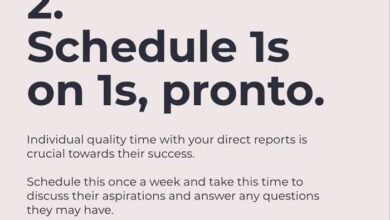
New Years resolutions for leaders are more than just personal goals; they’re strategic blueprints for organizational success. This guide dives deep into crafting resolutions that not only inspire individual growth but also drive positive change throughout the entire team. From defining the right resolutions to implementing them effectively, we’ll cover everything you need to know to lead with purpose and achieve meaningful results in the new year.
This in-depth exploration will cover everything from aligning resolutions with organizational goals to fostering a culture of continuous improvement within leadership teams. We’ll explore the different types of resolutions, from strategic to operational, and interpersonal, to understand how leaders can best approach their goals and the challenges they may face. Finally, we will provide a practical framework for maintaining momentum and making these resolutions sustainable long-term.
Defining Leadership Resolutions
Leadership resolutions are distinct from personal resolutions. While personal resolutions focus on individual growth and well-being, leadership resolutions are centered on improving organizational performance and fostering a positive impact on teams and the wider community. They’re about strategic vision, operational efficiency, and interpersonal effectiveness within a specific context. They are proactive steps taken by leaders to drive positive change, and their success is directly tied to the overall success of the organization.Effective leadership resolutions are not simply wishes; they are actionable plans.
They require a clear understanding of the organization’s strengths, weaknesses, opportunities, and threats (SWOT analysis). They also necessitate a commitment to continuous improvement, adaptability, and a focus on achieving measurable outcomes. These resolutions become catalysts for growth and innovation, ultimately benefiting the organization and its stakeholders.
Leadership Resolutions vs. Personal Resolutions
Leadership resolutions are distinct from personal resolutions. While personal resolutions address individual goals, leadership resolutions focus on organizational objectives. For example, a personal resolution might be to read more books, while a leadership resolution might be to implement a new training program to enhance team communication skills. This difference reflects the broader scope and impact of leadership.
Examples of Effective Leadership Resolutions
Leadership resolutions can be diverse, adapting to the specific needs and goals of the organization. A successful resolution for a tech company might involve investing in new technologies to streamline workflows, while a healthcare organization might prioritize employee well-being through improved work-life balance initiatives. These examples highlight the adaptability of leadership resolutions across different industries.
Importance of Alignment with Organizational Goals
Leadership resolutions must align with the overall organizational goals and strategic direction. This alignment ensures that individual leadership actions contribute to the collective success of the organization. For example, if a company’s primary goal is to expand into new markets, a resolution to improve sales training programs directly supports that objective.
Categorizing Leadership Resolutions
A framework for categorizing leadership resolutions can be helpful for effective implementation and tracking progress. This structure helps leaders organize their actions and ensure they are tackling crucial areas.
- Strategic Resolutions: These focus on long-term vision, setting the direction for the organization. Examples include developing a new product line or expanding into new markets. Strategic resolutions often require significant resource allocation and long-term commitment.
- Operational Resolutions: These focus on improving day-to-day processes and efficiency. Examples include implementing new software to streamline workflows or improving supply chain management. Operational resolutions are often about improving efficiency and reducing costs.
- Interpersonal Resolutions: These focus on enhancing relationships and communication within the team and organization. Examples include fostering a culture of open communication or improving conflict resolution strategies. Interpersonal resolutions are critical for building a strong and productive team environment.
Framework for Leadership Resolutions
A practical framework for defining and implementing leadership resolutions involves a structured approach:
- Define the Problem/Opportunity: Identify specific areas needing improvement or opportunities for growth.
- Set Measurable Goals: Define clear, quantifiable goals and objectives.
- Develop Actionable Steps: Create a detailed plan of actions to achieve the goals.
- Establish Metrics for Tracking Progress: Define key performance indicators (KPIs) to monitor progress.
- Seek Feedback and Adjust as Needed: Regularly review progress, gather feedback, and adjust the plan as required.
Motivating Leadership Change
New Year’s resolutions for leaders often go beyond personal goals; they reflect a desire for organizational growth and improvement. This drive to enhance leadership effectiveness stems from a variety of factors, both internal and external. Understanding these motivations is crucial for fostering a culture of continuous improvement within leadership teams.Leaders are frequently inspired to set resolutions by a need to address perceived weaknesses or enhance existing strengths.
This can range from improving communication skills to developing a more strategic approach to decision-making. The pursuit of excellence is a powerful motivator, driving leaders to strive for continuous self-improvement and elevate their teams’ performance.
Common Motivational Factors
Leaders are often driven by a desire for personal and professional development. This intrinsic motivation stems from a yearning to reach their full potential, and to contribute meaningfully to their organizations. Beyond personal growth, leaders often seek to improve their teams’ effectiveness and create a more positive work environment. They are often motivated to achieve tangible results, like increased profitability, higher employee satisfaction, or a stronger market position.
- Personal Growth: Leaders are often inspired by a desire to expand their skillset and knowledge. This can encompass areas like emotional intelligence, strategic thinking, or effective communication techniques. They might seek to become more adept at leading diverse teams or managing complex projects.
- Team Improvement: The desire to create a more effective and collaborative team is a powerful motivator.
Leaders may set resolutions focused on improving communication, fostering trust, and building a culture of innovation. This can lead to a more productive and engaged workforce.
- Organizational Success: Leaders frequently set resolutions to align with broader organizational goals. They may seek to enhance profitability, improve customer satisfaction, or expand market share. These goals are often intertwined with their personal aspirations and drive to contribute to the organization’s overall success.
Role of Personal Values and Aspirations
Personal values profoundly shape leadership resolutions. Leaders who prioritize integrity and fairness might set resolutions focused on ethical decision-making. Those valuing innovation might aim to foster a culture of creativity within their teams. The alignment between personal values and professional goals often drives a leader’s commitment to their resolutions. Personal aspirations, such as achieving a particular professional milestone or contributing to a significant societal impact, can also influence the resolutions leaders set.
These aspirations fuel a desire to achieve excellence and impact the world in a meaningful way.
Influence of External Factors
Market trends and industry challenges can significantly impact leadership resolutions. A rapidly evolving technological landscape, for example, might necessitate resolutions focused on digital transformation or adopting new technologies. Economic downturns or competitive pressures can prompt resolutions focused on cost-effectiveness, efficiency, and innovation. These external factors often necessitate adaptability and a willingness to adjust leadership strategies.
- Market Trends: Shifting market trends often demand leadership resolutions that align with the changing landscape. For instance, a growing emphasis on sustainability might motivate resolutions aimed at reducing the environmental footprint of the organization.
- Industry Challenges: Emerging challenges within an industry often necessitate leadership resolutions. For example, cybersecurity threats might lead to resolutions focused on strengthening data protection and implementing robust security protocols.
- Competitive Pressures: Increased competition often necessitates leaders to set resolutions that enhance the organization’s competitiveness. This can involve improving efficiency, increasing innovation, or enhancing customer experience.
Fostering a Culture of Continuous Improvement
Creating a culture of continuous improvement within leadership teams requires a multifaceted approach. This includes establishing clear expectations, providing opportunities for feedback, and promoting a supportive environment where leaders feel empowered to take risks and experiment with new approaches. Leaders must be willing to challenge the status quo and explore alternative solutions to overcome challenges and drive organizational progress.
- Regular Feedback and Review: Regular feedback mechanisms, both formal and informal, are essential for promoting continuous improvement. Leaders should actively seek feedback from their teams, peers, and superiors to identify areas for development and growth. Regular reviews of goals and progress provide an opportunity for adjustments and course corrections.
- Encouraging Experimentation: Leaders should foster an environment where experimentation and innovation are encouraged.
Providing resources, support, and a safety net for trial and error are essential for the continuous exploration of new strategies and approaches.
- Shared Responsibility: Establishing shared responsibility for continuous improvement across the entire leadership team fosters a sense of collective ownership. This approach empowers individuals to take initiative and contribute to the overall improvement process.
Crafting Effective Resolutions

New Year’s resolutions for leaders are often more than just personal goals; they represent a roadmap for organizational growth and improvement. Effectively crafting these resolutions ensures they translate into tangible, positive change, benefiting both the leader and the team. Transforming intentions into action requires a structured approach that focuses on realism, measurability, and actionable steps.Effective resolutions aren’t simply aspirations; they’re blueprints for success.
New Year’s resolutions for leaders often focus on innovation and growth, but sometimes the biggest hurdles aren’t just about strategy. For example, keeping up with the latest tech advancements is crucial, like Microsoft’s rumored new products, including mystery tablets not the only thing on Microsoft’s slate. Ultimately, successful leadership in 2024 hinges on adaptability and staying ahead of the curve, just like these tech giants are doing.
Leaders who translate their intentions into measurable actions are more likely to see positive outcomes. This involves breaking down ambitious goals into manageable steps, setting realistic timelines, and establishing clear metrics for success.
Actionable Steps for Realistic Resolutions
Developing resolutions that are both aspirational and achievable requires a deliberate process. Leaders must move beyond vague statements and focus on tangible actions. A crucial aspect of this process is to ensure the resolutions are aligned with the organization’s overall strategic objectives.
- Define Specific Objectives: Resolutions should be clearly defined, avoiding ambiguity. Instead of “improve communication,” a more effective resolution would be “implement a weekly team meeting format to discuss project progress and challenges.” This specificity allows for better tracking and evaluation of progress.
- Establish Realistic Timelines: Ambitious timelines often lead to failure. Leaders should break down large goals into smaller, manageable milestones with realistic deadlines. For example, instead of “increase sales by 20%,” consider “increase sales by 5% in Q1, 10% in Q2, and 5% in Q3.” This approach provides incremental progress and keeps the leader motivated.
- Identify Key Performance Indicators (KPIs): Quantifiable goals are essential for measuring progress. Clearly define KPIs that will track the success of each resolution. For instance, if the resolution is to “improve employee engagement,” KPIs could include employee satisfaction surveys, reduced employee turnover, and increased participation in company initiatives.
- Seek Input and Collaboration: Leaders shouldn’t develop resolutions in isolation. Engaging team members in the resolution-setting process fosters buy-in and collaborative ownership. A shared understanding and active participation in goal-setting lead to greater motivation and accountability.
Step-by-Step Resolution Formulation Process
A structured process ensures resolutions are well-considered and effective. This approach ensures leaders are proactively setting themselves and their teams up for success.
- Self-Assessment: Leaders should honestly evaluate their current performance and identify areas needing improvement. This internal reflection is the foundation for developing relevant resolutions.
- Strategic Alignment: Assess how the resolution aligns with organizational goals. This connection ensures the resolution contributes to the overall success of the team and company.
- Break Down into Milestones: Divide the resolution into smaller, more manageable steps. This approach provides a clear roadmap and allows for progress tracking at each stage.
- Identify Measurable Outcomes: Establish clear KPIs to track progress and measure success. This helps determine if the resolution is having the desired effect.
- Seek Feedback and Validation: Share the resolution with colleagues or mentors for feedback and support. This allows for external perspectives and adjustments.
Quantifiable Goals and Measurable Outcomes
Quantifiable goals are essential for demonstrating the impact of leadership resolutions. They provide a framework for tracking progress and ensuring accountability. This approach allows leaders to assess the effectiveness of their actions.
Using specific metrics ensures that the resolutions are grounded in reality and provide a clear pathway for achieving success. For instance, instead of “improve customer satisfaction,” a quantifiable goal might be “increase customer satisfaction scores by 15% within the next quarter.”
Examples of Successful Resolutions
Numerous examples demonstrate the positive impact of effective resolutions. Leaders across various fields have achieved notable results by implementing clear, measurable resolutions.
- Increased Employee Engagement: A CEO, concerned about declining employee morale, implemented weekly team-building activities and created transparent communication channels. This led to a 20% increase in employee engagement scores.
- Enhanced Customer Retention: A marketing director implemented a personalized email campaign, leading to a 15% rise in customer retention within six months. This quantifiable result directly tied to the resolution.
- Improved Operational Efficiency: A project manager established standardized workflows and implemented new software, reducing project completion time by 10%. This measurable outcome directly resulted from a well-defined resolution.
Implementing and Monitoring Progress

Turning New Year’s resolutions into tangible results requires a proactive approach. Leaders must move beyond simply setting goals to actively implementing strategies and meticulously monitoring progress. This proactive approach fosters accountability and ensures that resolutions are not merely aspirational but translate into tangible improvements.Effective implementation is not a one-time event but a continuous process. Leaders need to break down large resolutions into smaller, actionable steps.
This allows for focused effort and a clear understanding of progress at each stage. Monitoring progress becomes easier when milestones are clearly defined.
Strategies for Effective Implementation
A crucial element in implementing resolutions is developing a detailed plan. This plan should Artikel specific actions, timelines, and responsible parties. For example, if a resolution is to improve communication within a team, the plan might involve scheduling regular team meetings, implementing a project management tool, or establishing clear communication channels. Regular progress reviews will ensure that the plan stays on track.
Methods for Tracking Progress
Tracking progress toward resolution targets is essential for maintaining momentum and identifying areas needing adjustment. Establish key performance indicators (KPIs) that directly measure the success of each resolution. For instance, if a resolution is to increase employee engagement, KPIs might include employee feedback scores, participation rates in team activities, and the number of employee suggestions implemented.
Significance of Regular Self-Assessment and Feedback
Regular self-assessment is critical for evaluating the effectiveness of implementation strategies. Leaders should periodically reflect on their own progress, identify roadblocks, and adjust their approach as needed. Seeking feedback from team members, stakeholders, and mentors provides valuable insights that can help fine-tune strategies and identify blind spots. For instance, if a leader notices that team members are struggling with a new communication protocol, they can adjust their approach and provide additional training.
Techniques for Adjusting Resolutions Based on Evolving Circumstances
Circumstances often change, requiring leaders to adapt their resolutions. Flexibility is key. Leaders should be prepared to adjust strategies or timelines as needed. For example, if a market downturn forces a company to reconsider its growth strategies, the resolution to increase market share may need to be adapted to focus on cost-cutting and profitability measures. This adaptability demonstrates a leader’s ability to remain agile and responsive to changing environments.
Overcoming Obstacles and Challenges
Embarking on leadership resolutions is a journey, not a sprint. Leaders often face unexpected roadblocks and resistance during implementation. Recognizing these potential pitfalls and developing strategies to navigate them is crucial for success. This section explores the obstacles leaders might encounter and provides tools for overcoming them.The path to achieving leadership resolutions is rarely smooth. Leaders may encounter resistance from team members, stakeholders, or even themselves.
External factors, like economic downturns or market shifts, can also throw wrenches into the best-laid plans. Successful leaders understand that anticipating and preparing for these challenges is key to maintaining momentum and achieving their goals.
Identifying Potential Obstacles
Leaders face a variety of obstacles when implementing resolutions. These can be internal, stemming from personal beliefs or limitations, or external, arising from organizational structures or market conditions. Understanding the source of these obstacles is the first step toward overcoming them.
- Resistance to change: Team members may be hesitant to adopt new procedures or approaches, fearing the unknown or the disruption to their routines. This resistance often stems from a lack of understanding or perceived threat to their established roles.
- Lack of resources: Implementing a resolution might require additional funding, training, or personnel, but these resources may not be readily available. Leaders need to anticipate these needs and proactively seek solutions to secure the necessary support.
- Time constraints: Leadership resolutions often require significant time investment for planning, implementation, and evaluation. Overcommitting to other projects can lead to insufficient time for crucial resolution-related activities.
- External pressures: Market fluctuations, regulatory changes, or competitor actions can significantly impact a leader’s ability to execute resolutions effectively. Recognizing these external factors and adapting strategies accordingly is critical.
Strategies for Overcoming Resistance
Effective strategies for overcoming resistance to change are essential for successfully implementing leadership resolutions. Open communication and transparency are vital.
- Open Communication: Leaders must clearly articulate the reasons behind the resolution and its benefits to stakeholders. Providing regular updates and fostering a two-way dialogue can help address concerns and build consensus.
- Collaboration and Participation: Involve team members in the planning and implementation phases. Their input can lead to more effective solutions and greater buy-in. Encouraging participation fosters a sense of ownership and shared responsibility.
- Empathy and Understanding: Acknowledging the anxieties and concerns of those affected by the change is crucial. Empathetic leadership demonstrates that the organization values their contributions and perspectives.
- Addressing Concerns Directly: Creating a safe space for addressing concerns directly can help diffuse resistance. Active listening and a willingness to address anxieties constructively can help resolve issues.
Resilience and Perseverance
“The difference between ordinary and extraordinary is that little extra.”
Jimmy Johnson
Resilience and perseverance are essential traits for leaders navigating challenges. Leaders who maintain a positive attitude and persistent effort are more likely to overcome setbacks and achieve their goals. This involves recognizing setbacks as learning opportunities and adjusting strategies accordingly.
- Learning from Setbacks: Leaders must view setbacks not as failures, but as opportunities to learn and adapt. Analyze what went wrong, identify areas for improvement, and adjust strategies accordingly.
- Adaptability and Flexibility: Leaders must be adaptable and flexible in their approach to resolutions. Market conditions, team dynamics, and unforeseen circumstances might necessitate adjustments to strategies.
- Maintaining Focus: Leaders must maintain their focus on the long-term vision and objectives of their resolutions. Staying grounded and committed to the goals is essential during periods of adversity.
- Seeking Support: Don’t hesitate to seek support from mentors, advisors, or colleagues. Sharing experiences and seeking guidance can strengthen resilience and provide valuable perspectives.
Resources and Tools
Numerous resources and tools can assist leaders in addressing challenges related to resolution implementation.
- Change Management Frameworks: Models like Kotter’s 8-step framework or ADKAR provide structured approaches to managing organizational change. Utilizing these frameworks can guide leaders through the complexities of implementing resolutions.
- Communication Platforms: Utilizing effective communication platforms, such as internal newsletters, project management software, or intranets, facilitates transparency and ensures that everyone stays informed.
- Feedback Mechanisms: Implementing feedback mechanisms to assess the effectiveness of resolutions and gather input from stakeholders allows leaders to adapt their strategies in response to feedback.
- Mentorship Programs: Mentorship programs can provide guidance and support for leaders during the implementation phase. Mentors can offer valuable advice and insights, helping leaders navigate challenges effectively.
Promoting Collaboration and Teamwork
New Year’s resolutions for leaders often focus on individual performance. However, fostering a collaborative and teamwork-oriented environment is crucial for organizational success. A strong team dynamic can unlock innovation, improve problem-solving, and boost overall productivity. This approach goes beyond individual goals to embrace collective achievement.Effective leadership resolutions should actively encourage collaboration and teamwork. This requires a shift in mindset from individual achievement to shared success.
New Year’s resolutions for leaders often focus on efficiency and impact. Thinking about how to lead with both a strong vision and a focus on execution is key. Like the Droid X, which, according to this article on eTechMantra, droid x more athlete than aesthete , prioritizes functionality over aesthetics, leaders should strive for practical results in 2024.
Ultimately, strong leadership is about achieving tangible outcomes, not just looking good.
Leaders must recognize the value of diverse perspectives and create an atmosphere where team members feel empowered to contribute their unique skills and ideas. By prioritizing collaboration, organizations can unlock the full potential of their employees and achieve significant results.
How Leadership Resolutions Foster Collaboration
Leadership resolutions that promote collaboration often involve restructuring work processes to encourage teamwork. These resolutions may include implementing cross-functional teams, encouraging open communication channels, and establishing clear roles and responsibilities within projects. By defining roles and responsibilities, teams can focus on their objectives without confusion or overlap.
Examples of Successful Team-Based Resolutions
One successful resolution involved creating a cross-functional team to streamline the product development process. This team, composed of engineers, designers, and marketers, collaboratively identified bottlenecks and implemented solutions. The result was a 20% reduction in product development time. Another example involved implementing a “knowledge-sharing” program. Employees were encouraged to document their expertise and share it with colleagues, leading to a 15% increase in overall productivity.
These resolutions showcase how team-based initiatives can positively impact the organization.
Importance of Clear Communication and Shared Understanding
Clear communication is paramount in collaborative resolutions. Team members must understand the objectives, roles, and expectations. This shared understanding is the foundation of successful collaboration. Regular meetings, clear documentation, and transparent communication channels are essential for maintaining a high level of understanding. Ambiguity can quickly undermine collaboration, and this must be proactively addressed.
Using visual aids like project timelines and shared documents can significantly enhance comprehension.
Framework for Resolving Conflicts
Conflicts are inevitable in any team environment, particularly when implementing new resolutions. A well-defined framework for conflict resolution can help navigate disagreements constructively. This framework should include:
- Active Listening: Truly hearing and understanding the perspective of all involved parties. Avoid interrupting or formulating counterarguments while the other person is speaking. Focus on comprehending their concerns and viewpoints.
- Open Dialogue: Create a safe space for open and honest dialogue. Encourage all participants to express their concerns and ideas without fear of judgment. This requires an environment where individuals feel comfortable expressing their thoughts.
- Neutral Facilitation: If necessary, bring in a neutral third party to facilitate the discussion and help guide the team towards a mutually agreeable solution. This facilitator can help guide the discussion to a constructive conclusion.
- Collaborative Problem Solving: Focus on finding solutions that address the concerns of all involved parties. This requires a shift from blaming to brainstorming. Encouraging a collective approach can lead to creative and innovative solutions.
Long-Term Impact and Sustainability: New Years Resolutions For Leaders
New Year’s resolutions for leaders, if effectively implemented, can have a profound and lasting impact on organizational performance and growth. However, the true measure of success lies not just in initial adoption but in the ability to maintain momentum and integrate these resolutions into the long-term strategic vision of the organization. This requires a proactive approach to sustaining change and embedding resolution-setting practices into the very fabric of the company culture.Sustaining leadership resolutions over time demands a shift in mindset from a short-term focus to a long-term perspective.
This shift requires a commitment to continuous improvement and a willingness to adapt strategies based on evolving circumstances and emerging challenges. Organizations that successfully implement this paradigm often see increased employee engagement, improved operational efficiency, and enhanced innovation.
New Year’s resolutions for leaders often focus on innovation and strategic growth. Think about how Intel’s past ventures, like their foray into graphics processing with Larrabee, intel gravitates to graphics with larrabee , highlight the importance of embracing bold ideas and adapting to changing landscapes. Ultimately, these resolutions should inspire a forward-thinking approach to lead teams towards success.
Methods for Maintaining Momentum
Maintaining the momentum generated by New Year’s resolutions requires consistent effort and proactive strategies. These strategies must go beyond simply setting goals; they should encompass a comprehensive framework for monitoring progress, adapting to challenges, and celebrating successes.
- Regular Review and Adjustment: Leaders should schedule regular check-ins to assess the progress of their resolutions. These reviews should be open discussions, not just performance evaluations. This allows for adjustments to strategies and goals based on real-time feedback and emerging challenges.
- Integration into Performance Management Systems: Resolutions should be incorporated into performance management systems, making them integral components of ongoing performance reviews and goal-setting. This ensures accountability and reinforces the importance of the resolutions.
- Creating a Culture of Continuous Improvement: Fostering a culture that embraces continuous learning and improvement is essential for long-term resolution success. Leaders should encourage employees to identify areas for optimization and implement solutions that align with their goals.
Examples of Leaders with Long-Term Success
Numerous leaders have successfully integrated resolutions into their long-term leadership strategies. Their approach provides valuable insights into the methods for embedding resolutions into the organizational culture.
- Jack Welch at GE: Welch’s emphasis on continuous improvement and operational excellence is a testament to the long-term impact of leadership resolutions. His focus on developing strong leadership skills in employees and pushing them to excel became a cornerstone of GE’s success for decades. His commitment to a clear strategic direction and consistent execution was a critical factor in his long-term success.
- Mary Barra at General Motors: Barra’s commitment to ethical leadership and organizational transparency has significantly improved public perception and trust in General Motors. This is a direct result of her unwavering dedication to a consistent code of conduct.
Embedding Resolution-Setting Practices
Embedding resolution-setting practices into organizational culture requires a deliberate effort to integrate the process into the everyday routines of the organization. It’s not just about setting resolutions; it’s about creating a culture of continuous improvement and accountability.
- Leadership Training and Development: Leadership training programs should include modules on resolution-setting, implementation, and long-term sustainability. This ensures that all leaders understand the importance of these practices and are equipped with the tools to successfully implement them.
- Incentivizing and Recognizing Success: Recognizing and rewarding employees who contribute to the success of resolutions reinforces the importance of the process and encourages continued participation. Incentivizing and celebrating success can create a culture of accountability and engagement.
- Open Communication and Feedback: Open communication channels are vital for fostering an environment where employees feel comfortable sharing feedback and contributing to the improvement process. This is key to understanding obstacles and ensuring resolutions remain relevant and effective.
Resolutions for Specific Leadership Roles
New Year’s resolutions for leaders should be more than just vague aspirations. They should be tailored to the specific responsibilities and challenges of each role, from the strategic vision of a CEO to the operational efficiency of a team leader. Effective resolutions are not just about personal improvement; they are about improving the organization as a whole. By focusing on the unique needs of each leadership tier, leaders can create resolutions that yield measurable impact.
Comparative Analysis of Leadership Resolutions
Different leadership roles demand different approaches to setting and achieving resolutions. A CEO’s resolutions will often focus on the organization’s strategic direction and long-term goals, while department heads prioritize operational efficiency and team performance within their specific area. Team leaders, on the other hand, concentrate on fostering a positive team environment and individual development. Understanding these distinctions is crucial for formulating resolutions that are both relevant and impactful.
Resolutions for CEOs
CEOs need to focus on resolutions that drive the overall strategic direction of the organization. These resolutions often involve navigating market trends, adapting to technological advancements, and setting a clear vision for the future. A CEO’s resolution might include: improving market share by 10% through strategic partnerships; enhancing the organization’s digital presence; or fostering a culture of innovation and continuous improvement.
Resolutions for Department Heads
Department heads have a critical role in translating strategic goals into practical departmental initiatives. Their resolutions should focus on streamlining processes, optimizing resource allocation, and ensuring high-quality output. A department head’s resolution might include: reducing departmental expenses by 5% through process optimization; improving team productivity by 15% through training and development; or enhancing customer satisfaction metrics by implementing a new customer service protocol.
Resolutions for Team Leaders, New years resolutions for leaders
Team leaders are the front line in fostering a productive and engaged workforce. Their resolutions should concentrate on building strong relationships, empowering team members, and creating a supportive work environment. A team leader’s resolution might include: improving team morale by 20% through team-building activities; fostering a culture of collaboration and communication; or increasing employee retention through effective mentorship programs.
Comparative Table of Leadership Resolutions
| CEO | Department Head | Team Leader | |
|---|---|---|---|
| Focus Area | Strategic Vision, Organizational Growth | Operational Efficiency, Departmental Performance | Team Performance, Employee Development |
| Key Metrics | Market share, revenue growth, profitability | Departmental budget, productivity, customer satisfaction | Team morale, employee retention, project completion rate |
| Examples | Develop a new strategic plan, secure a major partnership | Streamline workflow, optimize resource allocation, reduce expenses | Implement a new training program, foster communication channels, enhance mentorship |
Ultimate Conclusion
In conclusion, successful New Year’s resolutions for leaders are about more than just personal ambitions. They are strategic commitments that shape organizational performance, driving teams toward shared goals and inspiring lasting growth. By understanding the nuances of leadership resolutions, from motivation and implementation to overcoming obstacles and fostering collaboration, leaders can confidently embark on a path of progress and lasting success.
This guide equips you with the tools and knowledge to effectively set and achieve impactful resolutions, not just for the new year, but for years to come.






